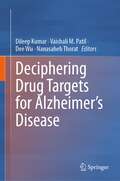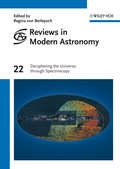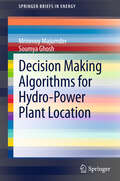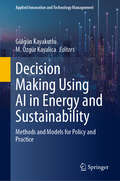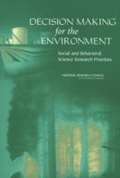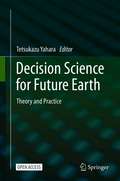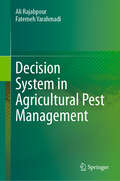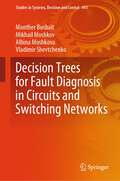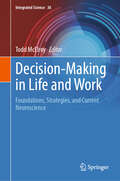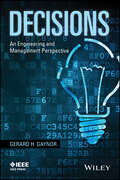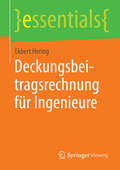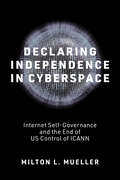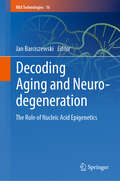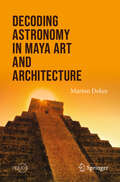- Table View
- List View
Deciphering Drug Targets for Alzheimer’s Disease
by Dileep Kumar Nanasaheb Thorat Vaishali M. Patil Dee WuThis book explains the fundamental characteristics and biofunctionality of Alzheimer’s Disease drug targets and provides up-to-date information on the full range of their biomedical applications. An introductory section gives an overview of the recent developments related to drug targets identified and studied related to Alzheimer’s Disease and key developments from preclinical and clinical studies focusing on various molecular targets related to AD and dementia by subject experts all around the globe. Here, individual chapters address the progress and perspectives in human and non-human research, role of various biomarkers as an overview, advanced gene therapy, and novel compounds for therapeutic targets for Alzheimer’s disease. The book will be essential reading for graduate students, scientists, and engineers in any of the biomedical research fields in which efforts are being made to utilize novel drug targets and develop effective strategies for new drug targeting and delivery in Alzheimer’s disease treatment.
Deciphering The Role of Succinate Dehydrogenase in Drug Discovery: SDH in Drug Discovery
by Satya P. Gupta Dileep Kumar Vaishali Manikrao PatilThe book explores various aspects of Succinate Dehydrogenase (SDH) (an enzyme crucial for cellular respiration and energy production) from its assembly and regulation mechanisms to its deficiency and its implications in related disorders. It also encompasses the impact of SDH in obstructive pulmonary disorders, discussing its potential contributions and implications. It explores the design and development of SDH inhibitors as potent agent against fungal infections. It further examines the relationship between SDH mutations and cancer development, linking genetic alterations to tumorigenesis. The book focuses on therapeutic strategies and highlights the role of SDH in managing gastrointestinal tumors, neurodegenerative disorders, and aging-related diseases. It navigates through the challenges and prospects of utilizing SDH as a target for therapeutic interventions. The book also dives into the diagnostic aspects of SDH defects, elucidating their implications and potential diagnostic investigations. It serves as a comprehensive guide to unravel SDH's functions, dysfunctions, and therapeutic potentials. By amalgamating diverse areas such as enzymology, genetics, pharmacology, and disease management, this book emerges as an invaluable resource for researchers, clinicians, and students alike.
Deciphering the Universe through Spectroscopy (Reviews in Modern Astronomy #22)
by Regina Von BerlepschThis 22nd volume in the series contains 15 invited reviews and highlight contributions from outstanding speakers presented during the 2009 annual meeting of the Astronomical Society on the subject of "Deciphering the Universe through Spectroscopy", held in Potsdam, Germany. Topics range from the measurements of magnetic fields on the surface of the sun via detailed measurements of abundances in stellar atmospheres to the kinematics of the universe at its largest scales. The result is a systematic overview of the latest astronomical and cosmological research.
Decision Analysis Applied to the Field of Environmental Health (Professional Practice in Earth Sciences)
by Dilber Uzun Ozsahin Berna Uzun James LaMoreaux Tamer SanlidagThis book provides students and researchers with a resource that includes the current application of the multi-criteria decision theory in a variety of fields, including the environment, health care, engineering, and architecture. There are many critical parameters (criteria) that can directly or indirectly affect the consequences of various decisions. The application of the multi-criteria decision theory focusses mainly on the use of computational methods which include multiple criteria and orders of preference for the evaluation and the selection of the best option among many alternatives based on the desired outcome. The theory of multi-criteria decision making (MCDM) is an approach that can be extremely useful for students, managers, engineers of manufacturing companies, etc.
Decision Making Algorithms for Hydro-Power Plant Location
by Mrinmoy Majumder Soumya GhoshThe present study has attempted to apply the advantage of neuro-genetic algorithms for optimal decision making in maximum utilization of natural resources. Hydro-power is one of the inexpensive, but a reliable source of alternative energy which is foreseen as the possible answer to the present crisis in the energy sector. However, the major problem related to hydro-energy is its dependency on location. An ideal location can produce maximum energy with minimum loss. Besides, such power-plant also requires substantial amount of land which is a precious resource nowadays due to the rapid and uncontrolled urbanization observed in most of the urban centres in the World. The feasibility of such plants also depends on social acceptance as well as the level of environmental casualty and economic benefit, all of which is also spatially dependent. Decision making algorithms are applied to identify better solution if a problem has more than one alternative explication. Nature based algorithms are found to be efficient enough to catalyze such kind of decision making analysis. That is why the present study tries to utilize nature based algorithms to solve the problems of location selection for hydropower plants. The study employed six different types of nature based algorithms to select one of the locations among many available for installation of hydropower plant in the North Eastern part of the Indian subcontinent. The locations are selected based on their in stream resources and included in the decision making as alternatives. A methodology of criteria selection, determination of weightage and applications of bioinspired algorithms are adopted to produce utmost exertion of the available natural resources with minimum hostility and wastage of the same.
Decision Making Using AI in Energy and Sustainability: Methods and Models for Policy and Practice (Applied Innovation and Technology Management)
by Gülgün Kayakutlu M. Özgür KayalicaArtificial intelligence (AI) has a huge impact on science and technology, including energy, where access to resources has been a source of geopolitical conflicts. AI can predict the demand and supply of renewable energy, optimize efficiency in energy systems, and improve the management of natural energy resources, among other things. This book explores the use of AI tools for improving the management of energy systems and providing sustainability with smart cities, smart facilities, smart buildings, smart transportation, and smart houses. Featuring research from International Federation for Information Processing's (IFIP) “AI in Energy and Sustainability” working group, this book provides new models and algorithms for AI applications in energy and sustainability fields. Any short-term, mid-term and long-term forecasting, optimization models, trend foresights and prescriptions based on scenarios are studied in the energy world and the smart systems for sustainability. The contents of this book are valuable for energy researchers, academics, scholars, practitioners and policy makers.
Decision Making and Modelling in Cognitive Science
by Sisir RoyThis book discusses the paradigm of quantum ontology as an appropriate model for measuring cognitive processes. It clearly shows the inadequacy of the application of classical probability theory in modelling the human cognitive domain. The chapters investigate the context dependence and neuronal basis of cognition in a coherent manner. According to this framework, epistemological issues related to decision making and state of mind are seen to be similar to issues related to equanimity and neutral mind, as discussed in Buddhist perspective. The author states that quantum ontology as a modelling tool will help scientists create new methodologies of modelling in other streams of science as well.
Decision Making for the Environment: Social and Behavioral Science Research Priorities
by National Research Council of the National AcademiesWith the growing number, complexity, and importance of environmental problems come demands to include a full range of intellectual disciplines and scholarly traditions to help define and eventually manage such problems more effectively. Decision Making for the Environment: Social and Behavioral Science Research Prioritiesis the result of a 2-year effort by 12 social and behavioral scientists, scholars, and practitioners. The report sets research priorities for the social and behavioral sciences as they relate to several different kinds of environmental problems.
Decision Making in Natural Resource Management: A Structured, Adaptive Approach
by Michael J. Conroy James T. PetersonThis book is intended for use by natural resource managers and scientists, and students in the fields of natural resource management, ecology, and conservation biology, who are confronted with complex and difficult decision making problems. The book takes readers through the process of developing a structured approach to decision making, by firstly deconstructing decisions into component parts, which are each fully analyzed and then reassembled to form a working decision model. The book integrates common-sense ideas about problem definitions, such as the need for decisions to be driven by explicit objectives, with sophisticated approaches for modeling decision influence and incorporating feedback from monitoring programs into decision making via adaptive management. Numerous worked examples are provided for illustration, along with detailed case studies illustrating the authors’ experience in applying structured approaches. There is also a series of detailed technical appendices. An accompanying website provides computer code and data used in the worked examples. Additional resources for this book can be found at: www.wiley.com/go/conroy/naturalresourcemanagement.
Decision Making in Timber Production, Harvest, and Marketing (Routledge Revivals)
by Marion ClawsonClawson explores the issues related to timber management with a particular focus on the harvesting of timber stands in Decision Making in Timber Production, Harvest and Marketing. Originally published in 1977, her study considers biological, economic and management implications of timber growing as well as the decision-making process in U.S forest Situations including methods of analysis. This title will be of interest to students of Environmental studies and professionals.
Decision Science for Future Earth: Theory and Practice
by Tetsukazu YaharaThis open access book provides a theoretical framework and case studies on decision science for regional sustainability by integrating the natural and social sciences. The cases discussed include solution-oriented transdisciplinary studies on the environment, disasters, health, governance and human cooperation. Based on these case studies and comprehensive reviews of relevant works, including lessons learned from past failures for predictable surprises and successes in adaptive co-management, the book provides the reader with new perspectives on how we can co-design collaborative projects with various conflicts of interest and how we can transform our society for a sustainable future. The book makes a valuable contribution to the global research initiative Future Earth, promoting transdisciplinary studies to bridge the gap between science and society in knowledge generation processes and supporting efforts to achieve the UN’s Sustainable Development Goals (SDGs). Compared to other publications on transdisciplinary studies, this book is unique in that evolutionary biology is used as an integrator for various areas related to human decision-making, and approaches social changes as processes of adaptive learning and evolution. Given its scope, the book is highly recommended to all readers seeking an integrated overview of human decision-making in the context of social transformation.
Decision Support Systems for Weed Management
by Guillermo R. Chantre José L. González-AndújarWeed management Decision Support Systems (DSS) are increasingly important computer-based tools for modern agriculture. Nowadays, extensive agriculture has become highly dependent on external inputs and both economic costs, as well the negative environmental impact of agricultural activities, demands knowledge-based technology for the optimization and protection of non-renewable resources. In this context, weed management strategies should aim to maximize economic profit by preserving and enhancing agricultural systems. Although previous contributions focusing on weed biology and weed management provide valuable insight on many aspects of weed species ecology and practical guides for weed control, no attempts have been made to highlight the forthcoming importance of DSS in weed management. This book is a first attempt to integrate `concepts and practice’ providing a novel guide to the state-of-art of DSS and the future prospects which hopefully would be of interest to higher-level students, academics and professionals in related areas.
Decision System in Agricultural Pest Management
by Ali Rajabpour Fatemeh YarahmadiThis book covers the theoretical and practical aspects of pest population components, explaining the probable reasons for pest density fluctuations and outbreaks in agricultural or other ecosystems. Agricultural pest management is a complex task that involves dealing with a variety of pests, including insects, diseases, and weeds. Decision systems can help farmers navigate this complexity by providing structured approaches to identify, monitor, and control pests. By making informed decisions based on data and models, farmers can reduce unnecessary pesticide applications, minimizing environmental impact and saving costs. This book aids in predicting pest outbreaks using population growth parameters and estimating economic crop losses through critical thresholds, illustrated with simple case studies. Additionally, the book covers image processing, remote sensing monitoring, and other novel methods for monitoring and quickly forecasting pest population outbreaks to developintegrated pest management (IPM) programs. The book is valuable for agricultural and entomological students (graduates and postgraduates), researchers, as well as pest managers and farmers.
Decision Trees for Fault Diagnosis in Circuits and Switching Networks (Studies in Systems, Decision and Control #493)
by Mikhail Moshkov Monther Busbait Albina Moshkova Vladimir ShevtchenkoIn this book, we study decision trees for fault diagnosis in circuits and switching networks, which are among the most fundamental models for computing Boolean functions. We consider two main cases: when the scheme (circuit or switching network) has the same mode of operation for both calculation and diagnostics, and when the scheme has two modes of operation—normal for calculation and special for diagnostics. In the former case, we get mostly negative results, including superpolynomial lower bounds on the minimum depth of diagnostic decision trees depending on scheme complexity and the NP-hardness of construction diagnostic decision trees. In the latter case, we describe classes of schemes and types of faults for which decision trees can be effectively used to diagnose schemes, when they are transformed into so-called iteration-free schemes. The tools and results discussed in this book help to understand both the possibilities and challenges of using decision trees to diagnose faults in various schemes. The book is useful to specialists both in the field of theoretical and technical diagnostics.It can also be used for the creation of courses for graduate students.
Decision and Game Theory for Security: 10th International Conference, GameSec 2019, Stockholm, Sweden, October 30 – November 1, 2019, Proceedings (Lecture Notes in Computer Science #11836)
by Tansu Alpcan Yevgeniy Vorobeychik John S. Baras György DánThis book constitutes the refereed proceedings of the 10th International Conference on Decision and Game Theory for Security, GameSec 2019,held in Stockholm, Sweden, in October 2019.The 21 full papers presented together with 11 short papers were carefully reviewed and selected from 47 submissions.The papers focus on protection of heterogeneous, large-scale and dynamic cyber-physical systems as well as managing security risks faced by critical infrastructures through rigorous and practically-relevant analytical methods.
Decision-Making in Energy Systems
by Vivek D. BhiseThis is a comprehensive book on how to make complex decisions on energy systems problems involving different technologies, environmental effects, costs, benefits, risks, and safety issues. Using Industrial and Systems Engineering techniques for decision-making in Energy Systems, the book provides the background knowledge and methods to incorporate multiple criteria involved in solving energy system problems. It offers methods, examples, and case studies illustrating applications. Decision-Making in Energy Systems discusses subjective as well as objective methods, approaches, and techniques taken from the systems and industrial engineering domain and puts them to use in solving energy systems problems. It uses an integrated approach by including effects of all technical, economic, environmental, and safety considerations as well as costs and risks. The book is specially designed for practicing engineers from industrial/systems engineering who work in energy systems engineering industries. Aimed at graduate students, researchers, and managers involved in various energy generating, distributing, and consuming companies, the book helps the reader to understand, evaluate, and decide on solutions to their energy-related problems.
Decision-Making in Environmental Health: From Evidence to Action
by D. Briggs C. Corvalan G. ZielhuisDecision-Making in Environmental Health examines the need for information in support of decision-making in environmental health. It discusses indicators of environmental health, methods of data collection and the assessment of exposure to and the health impact of different environmental risk factors.
Decision-Making in Life and Work: Foundations, Strategies, and Current Neuroscience (Integrated Science #36)
by Todd McElroyThis groundbreaking volume brings together leading researchers to explore the latest findings on the psychological and physiological factors that shape decision-making. It offers a uniquely multidisciplinary perspective, integrating insights from neuroscience, economics, public policy, and other fields to provide a comprehensive understanding of how we make choices in both personal and professional contexts. Designed for researchers, professionals, instructors, and students interested in decision science, this book delves into several key areas. It explores the cognitive biases and heuristics that influence our decisions. The book also examines the role of emotions and intuition in decision-making. Additionally, it investigates the neuroscience behind information processing and judgment. It also provides strategies we can use to make better decisions in real-world settings. The chapters, written by experts in the field, cover a wide range of topics ranging from the foundations of decision theory to the latest research on the neural bases of decision-making, providing readers with a rich understanding of the subject. Through its multidisciplinary approach and emphasis on practical applications, this volume offers readers valuable insights and tools for enhancing their own decision-making skills. Whether you are a researcher studying decision-making processes, a professional looking to make better judgments in important situations, or an instructor teaching decision science, this book provides a comprehensive and accessible resource that will deepen your understanding of this critical area of human behavior.
Decision-making Tools to Support Innovation: Guidelines and Case Studies
by Manon Enjolras Daniel Galvez Mauricio CamargoScientific thinking concerning the way in which we drive innovation has been widely developed in recent years. It is known that the process of innovation consists of a succession of decision-making processes that require simultaneous technical, economical, organizational and sustainable compromises. Indeed, all innovative activities in business require stakeholders to seek out the best compromise between various, often contradictory dimensions of the same problems. Through studying practical cases from various fields (e.g. energy, marketing and sustainable development), this book addresses all the stages of the innovation process, highlighting some of the main decisions that can be faced by organizations. Based on the historical research conducted at the ERPI Laboratory (University of Lorraine) in Nancy, France, this book presents six innovation practices: strategy, creativity, design, project management, human resources and capitalization of knowledge. These practices are then illustrated through examples of decision support methods' applications.
Decisions: An Engineering and Management Perspective
by Gerard H. GaynorDECISIONS focuses on how organizations can improve decision-making processes to improve organizational performance in a global economy. Presents research related to problems associated with meeting requirements, schedules, and costs Defines the scope of macro and micro decisions Raises the issue of the role of engineering, manufacturing, and marketing in making organizational decisions Includes references to Peter Drucker's studies on decision-making
Deckungsbeitragsrechnung für Ingenieure (essentials)
by Ekbert HeringDeckungsbeiträge dienen dazu, die Fixkosten eines Unternehmens bzw. der Unternehmensbereiche zu decken. Dazu müssen die fixen und die variablen Kosten bekannt sein. Der Deckungsbeitrag DB errechnet sich aus: DB = Netto-Umsatz - variable Kosten. Diese Kenngröße kann aus der Kostenrechnung leicht ermittelt werden, da Netto-Umsatz und variable Kosten in der Regel bekannt sind. Mit einer mehrstufigen Deckungsbeitragsrechnung können verschiedene Preisuntergrenzen definiert werden. Mit Deckungsbeiträgen können auch Marktpreise kalkuliert und eine Break-Even-Analyse durchgeführt werden (Bestimmung des Break-Even-Umsatzes: Umsatz, bei der gerade kein Gewinn oder Verlust auftritt oder der Break-Even-Stückzahl: Mindeststückzahl bei Gewinn = 0). Ausführliche Beispiele und Grafiken veranschaulichen die Zusammenhänge.
Declaring Independence in Cyberspace: Internet Self-Governance and the End of US Control of ICANN (Information Policy)
by Milton L. MuellerHow and why the US government gave up its control of ICANN, the global coordinator of internet names, numbers, and protocols—and what the geopolitical consequences were.In 1997 the United States decided that the Internet should be governed not by governments but by something called the &“global Internet community.&” In Declaring Independence in Cyberspace, Milton Mueller tells the story of why it took 20 years of organizational and geopolitical struggle to make that happen.ICANN (Internet Corporation for Assigned Names and Numbers), created in 1998, was the US government&’s answer to the question of who would control the Internet registries—a key part of the Internet infrastructure supporting domain names, network numbers, IP addresses, and other protocol parameters. Originally, ICANN was a bold institutional innovation based on a vision of Internet governance that was thoroughly globalized and independent of nation-states. Declaring Independence in Cyberspace explains where this vision came from, the problems posed by its implementation, and the organization&’s near-self destruction in its first five years.The US government refused to let go of ICANN for 15 years, triggering geopolitical conflicts over sovereignty and US power. Mueller details why, what prompted its change of heart, and how the problem of making ICANN accountable to its community in the absence of US government control sparked a political battle in Washington. His account gets to the very heart of a pressing question with profound global implications: Is state sovereignty the immutable foundation of global governance, or do new technological capabilities change the model?
Decoding Aging and Neurodegeneration: The Role of Nucleic Acid Epigenetics (RNA Technologies #16)
by Jan BarciszewskiThis book focuses on the close relationship between aging and neurodegeneration. By highlighting the reversible nature of epigenetic changes, it provides a comprehensive overview of how these modifications can regulate gene expression without altering the DNA sequence, offering promising solutions for clinical intervention. Aging induces a gradual decline in cerebral function, leading to cognitive impairment, memory loss, motor dysfunction, and eventually functional decline and death. It is accompanied by the decline of organismal functions induced by whole genome alterations leading to neurodegeneration. Epigenetic modifications, including chromatin modifications, DNA methylation, and changes in regulatory RNAs, have a major impact on neurodegenerative disorders such as Alzheimer's disease, Parkinson's disease, and Huntington's disease.The chapters in this book address critical issues such as the contribution of epigenetic mechanisms to aging, the interaction between genetic and environmental factors in neurodegeneration, and the potential for epigenetic therapies to delay aging and mitigate disease progression. This volume, part of the RNA Technologies book series, is an invaluable resource for researchers and advanced students in genetics and neuroscience. It provides a deep understanding of the molecular basis of neurodegenerative diseases and offers innovative strategies to address the challenges of aging and neurodegeneration.
Decoding Astronomy in Art and Architecture (Springer Praxis Books)
by Marion DolanFor centuries, our ancestors carefully observed the movements of the heavens and wove that astronomical knowledge into their city planning, architecture, mythology, paintings, sculpture, and poetry. This book uncovers the hidden messages and advanced science encoded within these sacred spaces, showing how the rhythmic motions of the night sky played a central role across many different cultures. Our astronomical tour transports readers through time and space, from prehistoric megaliths to Renaissance paintings, Greco-Roman temples to Inca architecture. Along the way, you will investigate unexpected findings at Lascaux, Delphi, Petra, Angkor Wat, Borobudur, and many more archaeological sites both famous and little known. Through these vivid examples, you will come to appreciate the masterful ways that astronomical knowledge was incorporated into each society’s religion and mythology, then translated into their physical surroundings. The latest archaeoastronomical studies and discoveries are recounted through a poetic and nontechnical narrative, revealing how many longstanding beliefs about our ancestors are being overturned. Through this celestial journey, readers of all backgrounds will learn the basics about this exciting field and share in the wonders of cultural astronomy.
Decoding Astronomy in Maya Art and Architecture (Springer Praxis Books)
by Marion DolanThe exciting discoveries and newest revelations in the field of archeoastronomy present fascinating examples of the importance of astronomy to the ancient Maya Civilization. Through technological advancements made in the archeoastronomy community, this book will allow you to uncover a time capsule from an ancient past. In a clear and comprehensible manner you will read about art and architecture from various important Maya cities, drawn from diverse time periods and from different geographical areas of Mesoamerica. The topics covered include new findings in wide variety of fields; including the history's of astronomy, science, art, architecture, literature and religion. You will explore in this book how the motions of the heavens were closely watched and notated by Maya astronomers and how those celestial objects determined the patterns of everyday life, religious rites, community festivals, agriculture, even birth and death! This book will open your mind to a deeper awareness and an even greater admiration for the Maya ingenuity in preserving their astronomical knowledge and passing it on to assist future generations. These latest findings will broaden our perception of the Maya cultures of the Pre-classic and their development through the Classic period and the remarkable changes that occurred throughout their 3000 years of history.
